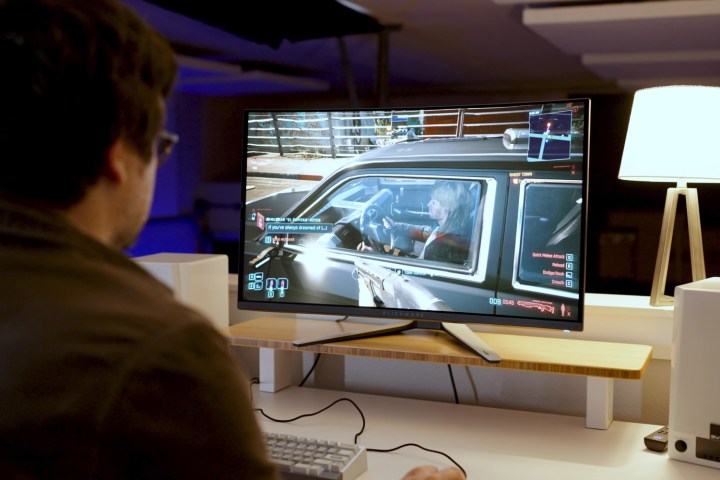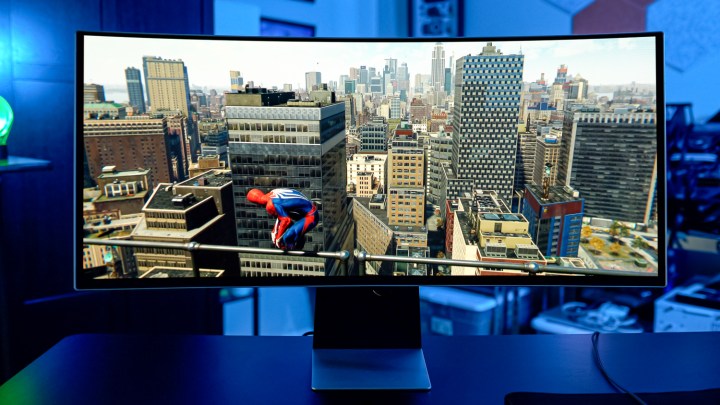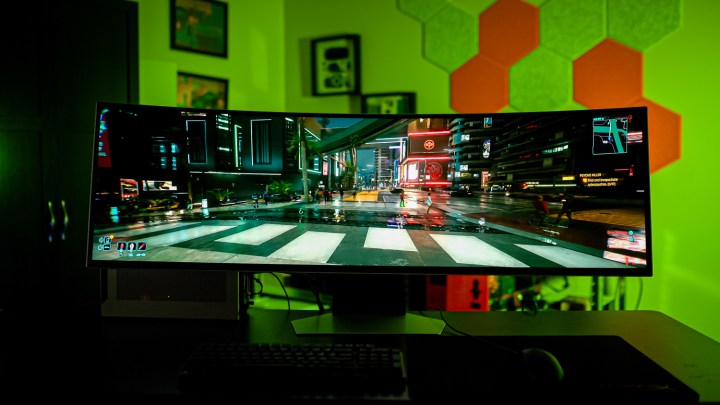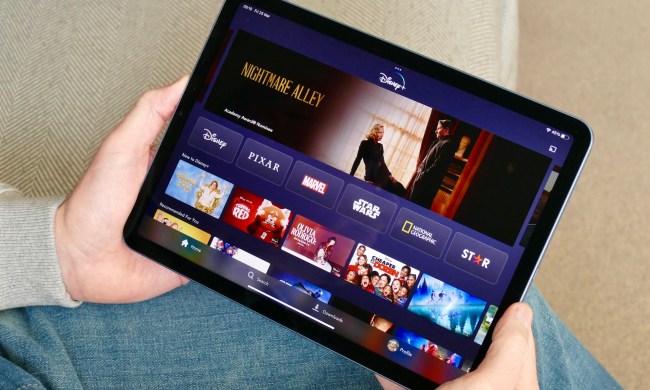OLED monitors offer a superior visual experience due to their self-emissive pixels, which produce light individually. This technology allows for incredibly deep blacks and a high contrast ratio, as each pixel can be turned off completely when displaying black, unlike traditional LCDs that rely on a backlight. Additionally, OLED monitors provide vibrant and accurate colors, wider viewing angles, and faster response times, making them ideal for gaming, graphic design, and high-definition media consumption.
Despite being more expensive than their LCD counterparts, the enhanced image quality and immersive viewing experience make OLED monitors a compelling choice for users seeking the best display performance. Notably, some OLED TVs are doubling as monitor alternatives, and they come equipped with compatible software features like AMD FreeSync Premium and Nvidia G-Sync.
Here are five compelling reasons to consider buying an OLED monitor:
Superior picture quality: OLED monitors deliver exceptional picture quality with vibrant colors and deep blacks. Each pixel emits its own light, allowing for true black levels by turning off individual pixels. This results in a higher contrast ratio and more vivid, lifelike images compared to traditional LCD monitors.
Wide viewing angles: OLED technology offers wide viewing angles without color distortion or loss of brightness. This means you can view the screen from almost any angle and still enjoy consistent color accuracy and image quality, making it ideal for collaborative work or entertainment.
Faster Response Times: OLED monitors typically have much faster response times than LCDs, reducing motion blur and ghosting in fast-moving scenes. This is particularly beneficial for gamers and professionals who work with high-speed video content, ensuring smooth and clear visuals.
Energy efficiency: OLED monitors are more energy-efficient because they don't require a backlight. Each pixel lights up individually, consuming power only when needed. This not only saves energy but also reduces heat output, contributing to a cooler and more comfortable workspace.
Slim and lightweight design: The absence of a backlight allows OLED monitors to be incredibly slim and lightweight. This sleek design not only looks modern and stylish but also saves desk space and is easier to mount or move around, enhancing the overall user experience.
If you are planning to buy a new monitor, now is a good time to invest in an OLED. Here's a look at some of the best ones that you can buy today.









The best OLED gaming monitor
Alienware 32 QD-OLED
- Fantastic HDR gaming
- Incredible out-of-box color accuracy
- Excellent console monitor
- High resolution, fast refresh rate
- Three-year warranty is great
- Fairly affordable
- Thick, plastic back
- No speakers
Why you should buy this: A premium OLED gaming monitor that justifies its high price point.
Who's it for: Gamers, developers and content creators who need a bright and color accurate monitor.
Why we chose the Alienware 32 QD-OLED:
The Dell Alienware 34-inch QD-OLED monitor was considered to be one of the best ultrawide gaming monitors on the market, but now we have a new 32-inch version, which is even better. Featuring the latest 32-inch 4K OLED display with an exceptional 240Hz refresh rate from Samsung, the monitor combines cutting-edge resolution with high-speed performance, making it a top choice for gaming enthusiasts. The QD-OLED panel brings OLED's renowned benefits of deep black levels, high contrast, and remarkable color accuracy to a monitor size, challenging the dominance of larger OLED TVs.
The AW3225QF boasts a similar design with the black and white Alienware aesthetics as its predecessor along with a subtle curve to the display providing an immersive viewing experience. Its variable refresh rate (VRR), auto low latency mode (ALLM), and G-Sync support ensure a seamless gaming experience with reduced input delay and screen tears.
With features like Dolby Vision support, pixel refresher, and a customizable RGB lighting system, the AW3225QF caters to the diverse needs of gamers. While lacking built-in speakers, the monitor offers an array of video and USB ports, including HDMI 2.1, DisplayPort 1.4, and eARC, ensuring versatile connectivity. With an MSRP of $1,200, the AW3225QF emerges as a premium investment for those seeking a cutting-edge OLED monitor.


Affordable alternative to the Alienware 32 QD-OLED
MSI MPG 321URX QD-OLED
- Much cheaper than the competition
- Some of the best color we've seen
- Extensive list of OLED burn-in prevention features
- 1,000 nits of brightness
- 3-year warranty that covers burn-in
- A rather bland design
- Limited to USB 2.0 with integrated hub
Why you should buy this: An excellent OLED monitor that is priced less than the competition.
Who's it for: Gamers and content creators who care about the best colors and visual quality.
Why we chose the MSI MPG 321URX QD-OLED:
The MSI MPG 321URX QD-OLED gaming monitor, offers impressive image quality at a relatively lower cost compared to its competitors, especially the Alienware 32 QD-OLED. Its standout features include exceptional color reproduction, OLED burn-in prevention mechanisms, a brightness of 1,000 nits, and a three-year warranty that covers burn-in. However, it does have some drawbacks such as a plain design and limited USB 2.0 connectivity with an integrated hub.
One of its major advantages is its competitive pricing strategy, significantly undercutting other OLED gaming monitors by $250 to $350. Despite the lower price point, the MPG 321URX doesn't compromise on performance or image quality, boasting a Samsung Display QD-OLED panel, 4K resolution, 240Hz refresh rate, and a host of gaming features like Adaptive Sync and DisplayHDR True Black 400. While it may lack certain advanced features like Black Frame Insertion (BFI) found in other models, its overall value proposition and comprehensive OLED burn-in prevention features make it a compelling choice for gamers looking for high-quality visuals without breaking the bank.


Best 27-inch OLED monitor
Asus ROG Swift PG27AQDP
- Insane motion clarity at 480Hz
- Useful 24.5-inch crop mode
- A slew of burn-in prevention settings
- Display Widget Center for monitor control
- No USB-C input
- Lacking a KVM
Why you should buy this: Hands down the best-performing OLED monitor at its size.
Who's it for: Anyone who is looking for a bright OLED monitor with limited desk space.
Why we chose the Asus ROG Swift OLED PG27AQDP:
The Asus ROG Swift OLED PG27AQDM impresses with its stunning 27-inch OLED display, delivering vibrant colors, deep blacks, and a mind-boggling 480Hz refresh rate. The 1440p resolution strikes a balance between visual clarity and high frame rates, while the fast response times ensure smooth performance. However, the brightness struggles in well-lit environments, and there's some risk of OLED burn-in, though ASUS's pixel-refreshing tech helps mitigate that. Overall, it's an excellent choice for gamers seeking top-tier visuals and fast performance.
On the downside, the monitor's cooling system is loud under heavy loads, which may distract users during gaming sessions. The lack of HDMI 2.1 also limits its appeal for next-gen console gamers. Despite these minor flaws, the PG27AQDM excels in its core purpose: delivering a premium OLED experience with incredibly smooth motion and vivid picture quality. For serious PC gamers looking for an OLED screen, this monitor offers an immersive and responsive experience, albeit at a steep price.


Exceptional OLED with smart features
Samsung Odyssey OLED G8 G85SB
- Exceptional color and HDR
- Ultrathin
- USB-C power delivery
- Dense settings in the OS
- More expensive than the competition
- Limited to mini connections
Why you should buy this: As good as the Alienware 34 QD-OLED, but with additional smart features.
Who's it for: Anyone who is looking for a premium OLED monitor that can also double as a multimedia hub.
Why we chose the Samsung Odyssey OLED G8:
Samsung’s Odyssey G8 OLED is a solid OLED monitor featuring a 34-inch WQHD (3440 x 1440) QD-OLED panel with a 175Hz refresh rate, and an 1800R curve. Like most OLED monitors it looks stunning for any form of media, with perfect black levels. It offers 100% sRGB, 99% coverage of DCI-P3 and 94% coverage of AdobeRGB. In our testing we noticed that at full brightness, the monitor was also very accurate in SDR, offering a color error of only 0.8 (anything under 2 is considered suitable for color work).
The Odyssey G8 also comes with additional smart features. There is Samsung’s Tizen OS built into the monitor, similar to the Samsung Smart Monitor M8. This gives you access to apps like Netflix and YouTube, Samsung’s Game Hub, and more. You also get a remote control, giving you easier access to settings and functionality. While the monitor is also suitable for gaming, it is notable that the Odyssey OLED G8 does not come with native Nvidia G-Sync support.


Unique bendable OLED gaming monitor
Corsair Xeneon Flex 45WQHD240
- Bendable panel
- 240Hz refresh rate and VRR
- Deep blacks
- Lower pixel density
- Increased input lag at low refresh rates
Why you should buy this: A unique ultrawide OLED that can be converted into a curved monitor.
Who's it for: Creative professionals, gamers, and content creators who want to experience the best of two worlds.
Why we chose the Corsair Xeneon Flex 45:
Corsair is a well-known name in the computing industry. It expanded its product range by launching monitors in 2023, and its flagship offering is the Xeneon Flex 45WQHD240. It is a one-of-a-kind OLED gaming monitor that comes with a bendable display.
Essentially, you can use it as a regular flat panel or use the two handles on the side to covert it into a curved monitor with an 800R curve. The 45-inch display comes with a 21:9 aspect ratio and a resolution of 3440 x 1440, which isn't the highest, so you can expect slightly lower pixel density compared to other OLED 4K monitors.
It uses an LG OLED panel with a high 240Hz refresh rate with low input lag, although it tends to increase at lower refresh rates. The panel supports FreeSync VRR and G-SYNC compatibility, and it also has HDMI 2.1. You get punchy colors and a deep black with almost no blooming effect around bright objects. You also get a KVM switch and Picture-in-Picture/Picture-by-Picture modes, as well as a wide array of I/O ports.
It's expensive, so if you don't like the bending gimmick, LG's UltraGear OLED 45 is a great alternative.


Best ultrawide OLED monitor
Samsung Odyssey OLED G9
- One of the best OLED displays we've tested
- Unmatched immersive gaming experience
- Speedy 240Hz refresh rate
- Dense settings options
- Full Tizen operating system
- Massive and expensive
- 32:9 doesn't play nicely with everything
Why you should buy this: An impressive ultrawide OLED monitor offering excellent vibrancy, color reproduction, and response time.
Who's it for: Those who care for peak immersion in games without having to compromise on real estate for productivity.
Why we chose the Samsung Odyssey OLED G9:
The Samsung Odyssey OLED G9, is hailed as a revolutionary gaming monitor, offering unparalleled immersion and a speedy 240Hz refresh rate. It carries a hefty price tag and its massive 32:9 aspect ratio may not be universally compatible with all content, but the monitor's OLED display delivers exceptional image quality and a truly immersive gaming experience.
With its expansive screen real estate that's equivalent to two 27-inch monitors, the Odyssey OLED G9 provides unmatched productivity potential alongside its gaming capabilities. The inclusion of the Tizen operating system enhances its versatility, offering access to streaming apps and gaming services, making it a multifunctional addition to any setup. However, its unique aspect ratio may present challenges with certain games and content formats, detracting from the otherwise stellar gaming experience. Despite its drawbacks, the Odyssey OLED G9's innovative design, impressive image quality, and extensive feature set make it a compelling choice for discerning gamers, particularly when available at discounted prices.


Best OLED smart TV
LG C3 OLED
- Delightful contrast
- Excellent color performance
- Very good processing
- Killer gaming features
- Five-year warranty
- Low-level color shift
- Too-frequent updates
Why you should buy this: It is one of the best OLED TVs on the market.
Who's it for: Those who want a high-quality console gaming experience.
Why we chose the LG C3 OLED:
The new LG C3 OLED TV continues the legacy of its predecessor and is our pick for the best OLED smart TV. Available in range of sizes starting from 42-inches all the way up to 83-inches, the new C3 is an excellent choice if you are looking for a premium OLED experience, especially if you are into console gaming. Expect flawless contrast, deep and inky blacks with minimal blooming around bright objects. The impressive viewing angle eliminates any concerns about discoloration and overall the TV provides a consistent and immersive experience.
It is worth noting that the C3 deviates from a standard RGB subpixel layout, resulting in less clear text when used as a monitor, and its SDR brightness takes a hit when the PC mode enabled. On the other hand, it is a fantastic TV for playing the latest games in HDR. The TV offers low input lag, making games incredibly responsive and supports popular resolutions like 1440p at 120Hz and 4K at 120Hz. Its excellent reflection handling, combined with satisfactory HDR brightness ensures an enjoyable gaming experience.
Other notable features include LG's proprietary webOS smart interface, four HDMI 2.1 ports and the company's latest processor that ensures improved image processing through LG's Brightness Booster Max and AI Tech technologies.


Best portable OLED monitor
Asus ZenScreen OLED MQ16AH
- Great color accuracy
- Light and portable
- Wide viewing angles
- No mounting capabilities
- Glossy panel
- Not the cheapest
Why you should buy this: A well-made compact OLED monitor that offers excellent color accuracy.
Who's it for: Anyone who wants a thin, portable monitor they can carry around.
Why we chose the Asus ZenScreen OLED MQ16AH:
Portable monitors, although in a niche category, prove valuable as secondary displays during travel. The Asus ZenScreen OLED stands out as an excellent choice, as it features a 15.6-inch Full HD (1920 x 1080) panel with up to 400 nits of brightness and an impressive contrast ratio of 100,000:1 (with HDR contrast reaching 1,000,000:1). Asus claims a swift 1ms response time (GtG) from the 60Hz panel, while the monitor itself features high-quality plastic construction.
The OLED panel on the portable monitor is capable of producing great colors with 100% DCI-P3 color gamut and Delta E < 2 color accuracy. It also features an embedded proximity sensor that helps in saving power and preventing image burn-in as it switches the monitor to a power-saving mode when it detects the user has moved away.
There is no mounting hardware or a built-in kickstand, but you do get a magnetic origami-style case that can be used to prop the display in both horizontal or vertical modes. In terms of ports, the monitor features a headphone jack, two USB-C/DisplayPort ports, an additional USB-C port for power, and one mini-HDMI port.

Frequently Asked Questions
OLED is short for Organic Light-Emitting Diode, which is a type of display technology used in screens commonly seen on TVs, monitors, smartphones, and other devices. OLED screens are made up of individual organic compounds that emit light when an electric current is applied to them. Unlike traditional LCD screens that require a backlight, OLED screens emit their own light on a pixel-by-pixel basis. This allows for deeper blacks, higher contrast ratios, and more vibrant colors, as each pixel can be turned on or off independently. OLED technology also often results in thinner and more flexible displays compared to traditional LCDs.
OLED displays tend to be more expensive compared to traditional LCD displays. This is primarily because the manufacturing process for OLED panels is more intricate and can be costlier. The organic materials used in OLED screens can be sensitive to moisture and oxygen, requiring specialized manufacturing facilities and techniques.
OLED monitors have a potential issue: burn-in. All OLED displays can suffer from burn-in, where static images will slowly fade into the screen over time, becoming a permanent blemish. OLED monitors are particularly prone to this problem due to desktop use, where you often have several parts of the screen occupied by static images. Thankfully, most OLED monitors come with burn-in prevention features like pixel shifting, and some displays such as the Alienware 34 QD-OLED, include multiyear warranties with burn-in protection.
LCD (Liquid Crystal Display) and OLED (Organic Light-Emitting Diode) are two distinct display technologies. LCDs use a backlight to illuminate pixels, with liquid crystals acting as shutters to control light passage. OLEDs, in contrast, utilize organic compounds that emit light when an electric current is applied, making each pixel self-emitting.
In terms of contrast ratio, LCDs may struggle to achieve true black levels due to the always-on backlight, resulting in a higher black level and lower contrast. OLEDs, however, can achieve perfect black levels, delivering a higher contrast ratio for more vibrant images. Viewing angles on LCDs may experience limitations, while OLED offers superior viewing angles, with consistent image quality from nearly any perspective.
There was a time when LCDs offered faster response times than OLEDs, but that is no longer the case. With improvements over time, modern OLED panels are extremely fast, offering up to a 360Hz refresh rate with up to 0.03ms response time. LCDs also consume more power due to the always-on backlight, whereas OLEDs are more energy-efficient, as each pixel is individually lit, consuming power only where needed.
Regarding life span, LCDs generally have a longer one, while OLEDs may experience degradation of organic compounds over time, potentially leading to a gradual decline in brightness and color accuracy. With that in mind, the choice between LCD and OLED depends on specific use cases, preferences, and budget considerations.
OLED and mini-LED are distinct display technologies with unique characteristics. OLED displays achieve deep blacks and infinite contrast by individually controlling pixel light emission, making them ideal for vibrant colors and high contrast ratios. On the other hand, mini-LED displays utilize thousands of smaller LEDs for backlighting, providing improved brightness, HDR performance, and local dimming compared to traditional LEDs. While OLED panels are thin and flexible with excellent color accuracy, they are susceptible to burn-in. In contrast, mini-LED displays offer enhanced brightness and HDR capabilities with reduced burn-in risks, but may they have uniformity issues and blooming. Overall, OLED is known for superior contrast and color accuracy, while mini-LED excels in brightness and HDR performance.
QD-OLED, or Quantum Dot OLED, is a relatively new display technology that combines the benefits of OLED (Organic Light-Emitting Diode) and Quantum Dots to enhance color accuracy, brightness, and efficiency. In QD-OLED displays, blue OLEDs act as the light source, and quantum dots convert this light into red and green colors, creating more vibrant, accurate colors compared to traditional OLEDs. This technology delivers deeper blacks, better contrast, and a wider color gamut, making it ideal for high-end TVs and monitors, particularly for gaming and media.




